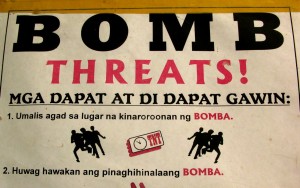 I recently met a Filipino journalist in General Santos City who doesn’t carry a reporter’s notebook. What Joseph Jubelag carries is a “Reporter’s Notebook And Safety Guide”. It is distributed by the International News Safety Institute, a group set up “to help journalists survive the story”. The notebook is prefaced with advice on how to stay alive in an increasingly hostile media environment: the Philippines.
I recently met a Filipino journalist in General Santos City who doesn’t carry a reporter’s notebook. What Joseph Jubelag carries is a “Reporter’s Notebook And Safety Guide”. It is distributed by the International News Safety Institute, a group set up “to help journalists survive the story”. The notebook is prefaced with advice on how to stay alive in an increasingly hostile media environment: the Philippines.
There is advice like this: “Conduct regular drills with family members on taking cover from gunfire, etc.” There is also a bleak section on enduring abduction and torture: “If you are being brutally treated, try to mentally converse with loved ones, or talk to your God.”
I’ve been thinking about Jubelag during what has been another deadly period for Philippine journalism. On June 19, a tabloid journalist called Nestor Bedolido was shot six times by an unidentified gunman while buying cigarettes. It is believed Bedolido’s exposés had upset a local politician. Two radio broadcasters, Joselito Agustin and Desiderio Camangyan, were gunned down just days before. The three now join a list of 140 journalists who have been murdered in the Philippines since 1986.
That was the year dictator Ferdinand Marcos was overthrown and democracy was, at least in theory, returned to all Filipinos. Since then, journalism has been an odd mix of licence and lethality. Filipino journalists have “historically ranked among the freest, most vibrant, and most outspoken in Southeast Asia,” says Freedom House in its global assessment of media freedom. At the same time, they are also among the world’s most imperiled.
In short, you are free to write about who and what you want, but your subjects are free to kill you for doing so.
It is no surprise to find the Philippines in third place, after war-torn Iraq and Somalia, on the 2010 Impunity Index, compiled by the Committee to Protect Journalists (CPJ). The index names countries “where journalists are slain and killers go free”.
Catching and convicting the killers is neither impossible nor unprecedented. In the past 14 months, the murderers of journalists Edgar Amoro (killed in 2005) and Armando Pace (2006) have received lengthy jail sentences. But President Gloria Macapagal-Arroyo, who leaves office this week, has little to boast about, since 107 of the 140 murders took place on her watch.
So did the single deadliest attack on the media that the CPJ has ever documented. Last November, gunmen belonging to a powerful warlord allied with Arroyo massacred 57 men and women in the southern province of Maguindanao. At least 30 were media workers.
If only Arroyo’s departure alone would mean an end to the slaughter. Will President-elect Benigno Aquino do any better? His parents were icons of freedom: his father was assassinated, his late mother stared down a dictator. What better way to prove his democratic pedigree than by halting these murders? After all, many of the dead were killed for exposing the very corruption Aquino was elected to fight.
A version of this post appeared in the opinion pages of the South China Morning Post.








Written by Andrew Marshall
Posted on 28 June 2010